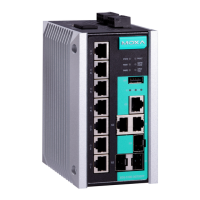
Do you have a question about the Moxa Technologies E Series and is the answer not in the manual?
| Series | E Series |
|---|---|
| Category | Network Router |
| Ports | Varies by model (e.g., 4 to 16 ports) |
| Power Input | Varies by model |
| Operating Temperature | Varies by model |
Explains initial installation and access methods for the Moxa switch.
Details configuration, monitoring, and administration functions of the Moxa switch.
Step-by-step guide for configuring the switch via the USB console interface.
Instructions for accessing and configuring the switch using the CLI.
Guides users on how to configure the switch through the web browser interface.
Procedures for disabling Telnet and web browser access for security.
Provides an overview of the switch's system information and status.
Covers essential configuration and management settings for the switch.
Details IP settings, DNS, and Date/Time configurations for network management.
Explains Virtual LAN concepts and configuration options for network segmentation.
Covers port settings, status, flow control, and link aggregation configurations.
Discusses multicast filtering, IGMP snooping, and GMRP protocols.
Details Quality of Service and traffic prioritization mechanisms for network performance.
Covers login authentication, management interface, and trusted access controls.
Explains DHCP IP-Port binding and relay agent configurations.
Details SNMP versions, security modes, and trap configurations for network monitoring.
Discusses support for EtherNet/IP, Modbus TCP, and PROFINET I/O protocols.
Introduces tools for network troubleshooting like LLDP, Ping, and Port Mirror.